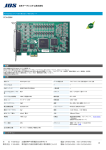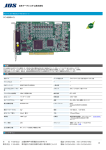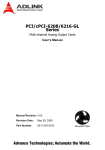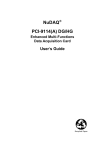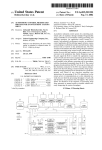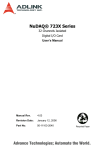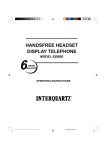Download NuDAQ 6208/6216 Series
Transcript
NuDAQ 6208/6216 Series Multi-channel Analog Output Cards User’s Guide Recycled Paper ©Copyright 1999~2000 ADLINK Technology Inc. All Rights Reserved. Manual Rev. 3.21: April, 2001 The information in this document is subject to change without prior notice in order to improve reliability, design and function and does not represent a commitment on the part of the manufacturer. In no event will the manufacturer be liable for direct, indirect, special, incidental, or consequential damages arising out of the use or inability to use the product or documentation, even if advised of the possibility of such damages. This document contains proprietary information protected by copyright. All rights are reserved. No part of this manual may be reproduced by any mechanical, electronic, or other means in any form without prior written permission of the manufacturer. Trademarks NuDAQ, NuIPC, DAQBench are registered trademarks of ADLINK Technology Inc. Other product names mentioned herein are used for identification purposes only and may be trademarks and/or registered trademarks of their respective companies. Getting service from ADLINK Customer Satisfaction is always the most important thing for ADLINK Tech Inc. If you need any help or service, please contact us and get it. ADLINK Technology Inc. Web Site http://www.adlinktech.com Sales & Service [email protected] NuDAQ [email protected] Technical NuDAM [email protected] Support NuIPC [email protected] NuPRO [email protected] TEL +886-2-82265877 FAX +886-2-82265717 Address 9F, No. 166, Jian Yi Road, Chungho City, Taipei, 235 Taiwan, Please inform us of your detailed information for a prompt, satisfactory and constant service. Detailed Company Information Company/Organization Contact Person E-mail Address Address Country TEL FAX Web Sit Questions Product Model Environment to Use Challenge Description Suggestions for ADLINK ¨ OS ¨ Computer Brand ¨ M/B: ¨ CPU: ¨ Chipset: ¨ BIOS: ¨ Video Card: ¨ Network Interface Card: ¨ Other: Table of Contents Chapter 1 Introduction................................................. 1 1.1 1.2 1.3 1.4 Features............................................................................. 2 Applications........................................................................ 2 Specifications ..................................................................... 2 Software Supporting ........................................................... 4 1.4.1 1.4.2 1.4.3 1.4.4 1.4.5 1.4.6 1.4.7 1.4.8 1.4.9 Programming Library...................................................................4 ® PCIS-LVIEW: LabVIEW Driver.................................................5 PCIS-VEE: HP-VEE Driver.........................................................5 DAQBenchTM: ActiveX Controls..................................................6 DASYLab TM PRO.........................................................................6 PCIS-DDE: DDE Server and InTouchTM ...................................6 PCIS-ISG: ISaGRAF TM driver.....................................................6 PCIS-ICL: InControlTM Driver......................................................6 PCIS-OPC: OPC Server .............................................................6 Chapter 2 Installation................................................... 7 2.1 2.2 2.3 2.4 2.5 2.6 2.7 What You Have .................................................................. 7 Unpacking .......................................................................... 8 PCB Layout ........................................................................ 9 Connector Pin Assignment ............................................... 11 Hardware Installation Outline ............................................ 12 Device Installation for Windows Systems .......................... 13 Termination Board Connection ......................................... 13 Chapter 3 Registers Format ...................................... 14 3.1 3.2 3.3 3.4 3.5 PCI PnP Registers............................................................ 14 I/O Address Map............................................................... 15 Analog Output Status Register.......................................... 15 Digital Output Register...................................................... 16 Digital Input Register ........................................................ 16 Chapter 4 Operation Theorem................................... 17 4.1 4.2 Voltage Output ................................................................. 17 Current Output and Range Control ................................... 18 Chapter 5 C\C++ Library ............................................ 19 5.1 Libraries Installation.......................................................... 19 Table of Contents • i 5.2 Programming Guide.......................................................... 20 5.2.1 5.2.2 5.3 5.4 5.5 5.6 5.7 5.8 5.9 Naming Convention...................................................................20 Data Types.................................................................................20 _6208_Initial..................................................................... 21 _6208_Software_Reset .................................................... 22 _6208_DA........................................................................ 23 _6208_Get_DA_Status..................................................... 24 _6208_DI.......................................................................... 25 _6208_DO........................................................................ 26 _6208_I2V_Control........................................................... 27 Chapter 6 Utility / Calibration .................................... 28 6.1 Running the 6208util.exe .................................................. 28 6.1.1 6.1.2 6.2 Functional Testing .....................................................................29 Calibration..................................................................................30 Calibration of Analog Output Channel ............................... 32 6.2.1 6.2.2 6.2.3 6.2.4 What You Need .........................................................................32 VR Assignemnt of cPCI/PCI-6208 and PCI-6216....................32 Voltage Output Calibration........................................................33 Current Output Calibration........................................................33 Product Warranty/Service .......................................... 34 ii • Table of Contents How to Use This Guide This manual is designed to help you use the 6208 series products. It describes how to modify and control various functions on these products to meet your requirements. It is divided into six chapters: l Chapter 1, "Introduction", gives an overview of the product features, applications, and specifications. l Chapter 2, "Installation", describes how to install the 6208 series products. The layout of 6208 series products are shown, the connectors specifications, and the notes for installation are described. l Chapter 3, "Registers Format", describes the details of register format and structure of the 6208 series products, this information is very important for the programmers who want to control the hardware by low-level programming. l Chapter 4, "Operation Theorem", describes more detail concept about 6208’s functions, including analog output and range control systems. l Chapter 5, "Software Library", describes the software libraries for programming the 6208 series cards. The software libraries for DOS and Windows 95 are provided. It helps users to control 6208 series cards in high-level programming languages. l Chapter 6, "Utility/Calibration", describes how to run the utility program included in the software CD. And how to calibrate the 6208 series cards for accurate operation. How to Use This Guide • iii 1 Introduction The 6208 series products are multi-channel analog output cards. They include the following three products: l cPCI/PCI-6208V: 8-CH voltage output card for cPCI/PCI interface l cPCI/PCI-6208A: 8-CH voltage and current output card for cPCI/PCI interface l PCI-6216V: 16-CH voltage output card for PCI interface cPCI-6208V, PCI-6208V: cPCI/PCI-6208V is a high-density analog output card with 8 identical voltage output channels. Each channel is equipped with BB.PCM56U, which is a state-of-the-art fully monotonic, digital to analog converter. This device employs ultra-stable nichrome (NiCr) thin-film resistors to provide monotonicity, low distortion, and low differential linearity error over long period of time. cPCI-6216V, PCI-6216V: cPCI/PCI-6216V is a high-density analog voltage output card, it is a combination of cPCI/PCI-6208 with EXP-8V daughter board. The EXP-8V is an extended board which includes extra 8 voltage output channels. cPCI-6208A, PCI-6208A: cPCI/PCI-6208A is a high-density current source output card, it is a combination of cPCI/PCI-6208V with EXP-8A daughter board. The EXP8A includes 8 precision voltage-to-current converters, which convert voltage outputs from cPCI/PCI-6028V to current source outputs. Introduction • 1 1.1 Features l 32-bit cPCI/PCI-Bus, Plug and Play l 16-bit high resolution voltage outputs l Output Range: ±10V (14-bit resolution guarantee) for cPCI/PCI-6208V and PCI-6216V only l Output Range: 0-20mA, 4-20mA, 5-25mA (14-bit resolution guarantee) for cPCI/PCI-6208A only l 0.001% of FSR typical. Differential linearity error l Fast 2 µs voltage settling time (-10V~+10V) l On board DC-to-DC converter to provide stable power and current source for analog outputs 1.2 Applications l Industrial Process Control l Pressure/Temperature Transmitter l Current Source for Testing Equipment l Function Generator 1.3 Specifications u Voltage Output • • • • • • • • • • • Numbers of channel: 8 channels for cPCI/PCI-6208V and cPCI/PCI-6208A 16 channels for PCI-6216V Converter: B.B. PCM56U or equivalent Conversion type: Monolithic multiplying Resolution: 16-bit (14-bit guarantee) Voltage output ranges: ±10V Voltage output driving capability: ± 5mA max. Settling time: 2µ second (-10V to +10V) Gain error: ± 0.2 % (max, without trimming) Differential Linearity Error: ± 0.001 % Full Scale Range Output initial status : 0V (after RESET or POWER-ON) Data Transfer: Programmed I/O 2 • Introduction u Current Output • • Numbers of channel: 8 channel for c PCI/PCI-6208A Current output range : (programmable) • • • • • • • q 0~20mA, 4~20mA, 5~25mA. Voltage to current converter: B.B. XTR110 or equivalent Settling time: 17 µ second (from 0 to 20mA) Slew rate: 1.3 mA / µs Non-linearity: ± 0.01 % of Span Span error: 0.3% of initial Span Output resistance: 10 Ohms maximum Output initial status : 0mA (after RESET or POWER-ON) u Digital I/O • • • • Channel: 4 TTL compatible inputs and outputs Input Voltage: Low: Min. 0V; Max. 0.8V High: Min. +2.0V; Max. 5.5V Input Load: Low: +0.8V @ -0.2mA max. High: +2.7V @ +20mA max. Output Voltage: Low: Min. 0V; Max. 0.4V High: Min. +2.4V; Max. 5.5V Driving Capacity: Low: Max. +0.5V at 8.0mA (Sink) High: Min. 2.7V at 0.4mA (Source) u General Specifications • • • • • • Operating temperature: 0° ~ 50°C Storage temperature: -20° ~ 80°C Humidity: 5 ~95% non-condensing Connector: 37-pin D-sub connector (female) Bus interface: 32-bit slave PCI bus Power consumption: •PCI-6208V: +5VDC @ 580mA typical +12VDC @ 70mA typical Introduction • 3 •PCI-6208A: •PCI-6216V: • +5VDC @ 670mA typical +12VDC @ 90mA typical or +12VDC @ 380mA (when all current output channel is 20mA) +5VDC @ 1.20 typical +12VDC @ 110mA typical •cPCI-6208V: +5VDC @ 560mA typical +12VDC @ 70mA typical •cPCI-6208A: +5VDC @ 650mA typical +12VDC @ 90mA typical or +12VDC @ 370mA (when all current output channel is 25mA) PCB Dimension: Half-sized •PCI series: 172 mm x 105 mm •cPCI series: 160 mm x 100 mm 1.4 Software Supporting ADLINK provides versatile software drivers and packages for users’ different approach to built-up a system. We not only provide programming library such as DLL for many Windows systems, but also provide drivers ® for many software package such as LabVIEW , HP VEE TM, DASYLab TM, TM TM TM InTouch , InControl , ISaGRAF , and so on. All the software options are included in the ADLINK CD. The non-free software drivers are protected with serial licensed code. Without the software serial number, you can still install them and run the demo version for two hours for demonstration purpose. Please contact with your dealer to purchase the formal license serial code. 1.4.1 Programming Library For customers who are writing their own programs, we provide function libraries for many different operating systems, including: DOS Library: Borland C/C++ and Microsoft C++, the functions descriptions are included in this user’s guide. Windows 95 DLL: For VB, VC++, Delphi, BC5, the functions descriptions are included in this user’s guide. 4 • Introduction PCIS-DASK: Include device drivers and DLL for Windows 98, Windows NT and Windows 2000. DLL is binary compatible across Windows 98, Windows NT and Windows 2000. That means all applications developed with PCIS-DASK are compatible across Windows 98, Windows NT and Windows 2000. The developing environment can be VB, VC++, Delphi, BC5, or any Windows programming language that allows calls to a DLL. The user’s guide and function reference manual of PCIS-DASK are in the CD. Please refer the PDF manual files under \\Manual_PDF\Software\PCIS-DASK PCIS-DASK/X: Include device drivers and shared library for Linux. The developing environment can be Gnu C/C++ or any programming language that allows linking to a shared library. The user's guide and function reference manual of PCIS-DASK/X are in the CD. (\Manual_PDF\Software\PCIS-DASK-X.) The above software drivers are shipped with the board. Please refer to the “Software Installation Guide” to install these drivers. 1.4.2 PCIS-LVIEW: LabVIEW ® Driver PCIS-LVIEW contains the VIs, which are used to interface with NI’s ® LabVIEW software package. The PCIS-LVIEW supports Windows ® 95/98/NT/2000. The LabVIEW drivers are free shipped with the board. You can install and use them without license. For detail information about PCIS-LVIEW, please refer to the user’s guide in the CD. (\\Manual_PDF\Software\PCIS-LVIEW) 1.4.3 PCIS-VEE: HP-VEE Driver The PCIS-VEE includes the user objects, which are used to interface with HP VEE software package. PCIS-VEE supports Windows 95/98/NT. The HP-VEE drivers are free shipped with the board. You can install and use them without license. For detail information about PCIS-VEE, please refer to the user’s guide in the CD. (\\Manual_PDF\Software\PCIS-VEE) Introduction • 5 1.4.4 DAQBenchTM : ActiveX Controls We suggest the customers who are familiar with ActiveX controls and VB/VC++ programming use the DAQBenchTM ActiveX Control components library for developing applications. The DAQBenchTM is designed under Windows NT/98. For more detailed information about DAQBench, please refer to the user’s guide in the CD. (\\Manual_PDF\Software\DAQBench\DAQBench Manual.PDF) 1.4.5 DASYLabTM PRO DASYLab is an easy-to-use software package, which provides easy-setup instrument functions such as FFT analysis. Please contact us to get DASYLab PRO, which include DASYLab and ADLINK hardware drivers. 1.4.6 PCIS-DDE: DDE Server and InTouchTM DDE stands for Dynamic Data Exchange specifications. The PCIS-DDE includes the PCI cards’ DDE server. The PCIS-DDE server is included in the ADLINK CD. It needs license. The DDE server can be used conjunction with any DDE client under Windows NT. 1.4.7 PCIS-ISG: ISaGRAFTM driver The ISaGRAF WorkBench is an IEC1131-3 SoftPLC control program development environment. The PCIS-ISG includes ADLINK products’ target drivers for ISaGRAF under Windows NT environment. The PCISISG is included in the ADLINK CD. It needs license. 1.4.8 PCIS-ICL: InControlTM Driver PCIS-ICL is the InControl driver which support the Windows NT. The PCIS-ICL is included in the ADLINK CD. It needs license. 1.4.9 PCIS-OPC: OPC Server PCIS-OPC is an OPC Server, which can link with the OPC clients. There are many software packages on the market can provide the OPC clients now. The PCIS-OPC supports the Windows NT. It needs license. 6 • Introduction 2 Installation This chapter describes how to install the 6208 series card. Please follow the following steps to complete the installation. l Check what you have (section 2.1) l Unpacking (section 2.2) l Check the PCB and jumper location(section 2.3) l Install the hardware and setup and jumpers (section 2.4, 2.7) l Install the software drivers and run utility to test (section 2.5) l Cabling with external devices (section 2.6, 2.8) 2.1 What You Have In addition to this User's Manual, the package includes the following items: l 6208 Series Card l ADLINK CD l Software Installation Guide If any of these items is missing or damaged, contact the dealer whom you purchased the product from. Save the shipping materials and carton in case you want to ship or store the product in the future. Installation • 7 2.2 Unpacking Your 6208 series card contains sensitive electronic components that can be easily damaged by static electricity. The card should be done on a grounded anti-static mat. The operator should be wearing an anti-static wristband, grounded at the same point as the anti-static mat. Inspect the card module carton for obvious damage. Shipping and handling may cause damage to your module. Be sure there are no shipping and handing damages on the module before processing. After opening the card module carton, exact the system module and place it only on a grounded anti-static surface component side up. Note: DO NOT APPLY POWER TO THE CARD IF IT HAS BEEN DAMAGED. You are now ready to install your 6208 series card. 8 • Installation 2.3 PCB Layout Figure 2.1a PCI-6208 Layout Installation • 9 Figure 2.1b cPCI-6208 Layout 10 • Installation 2.4 Connector Pin Assignment The pin assignment of 6208 series card are shown in Figure 2.2 DI3 (1) DI2 (2) DI1 (3) DI0 (4) GND (5) +5V (6) +15V (7) A.GND (8) V14(A6) (9) V6 (10) A . G N D (11) V12(A4) (12) V4 (13) A . G N D (14) V10(A2) (15) V2 (16) A . G N D (17) V8(A0) (18) V0 (19) (20) D O 3 (21) D O 2 (22) D O 1 (23) D O 0 (24) G N D (25) -15V (26) A . G N D (27) V15(A7) (28) V7 (29) A . G N D (30) V13(A5) (31) V5 (32) A . G N D (33) V11(A3) (34) V3 (35) A . G N D (36) V9(A1) (37) V1 Figure 2.2 Pin Assignment of CN1 connector The analog output pin names are specified as Vn or An, where Vn : means the voltage output with channel number n for cPCI/PCI-6208V, n=0~7 for PCI-6216V, n =0~15 An : means the current output with channel number n for cPCI/PCI-6208A only, n =0~7 The digital input and output pin names are specified as DIn and DOn respectively, where n =0~3. Installation • 11 2.5 Hardware Installation Outline Hardware configuration The PCI cards (or CompactPCI cards) are equipped with plug and play PCI controller, it can request base addresses and interrupt according to PCI standard. The system BIOS will install the system resource based on the PCI cards’ configuration registers and system parameters (which are set by system BIOS). Interrupt assignment and memory usage (I/O port locations) of the PCI cards can be assigned by system BIOS only. These system resource assignments are done on a board-by-board basis. It is not suggested to assign the system resource by any other methods. PCI slot selection The PCI card can be inserted to any PCI slot without any configuration for system resource. The CompactPCI card can also be inserted to any CompactPCI I/O slot. Installation Procedures 1. Turn off your computer 2. Turn off all accessories (printer, modem, monitor, etc.) connected your computer. to 3. Remove the cover from your computer. 4. Setup jumpers on the PCI or CompactPCI card. 5. Select a 32-bit PCI slot. PCI slot are short than ISA or EISA slots, and are usually white or ivory. 6. Before handling the PCI cards, discharge any static buildup on your body by touching the metal case of the computer. Hold the edge and do not touch the components. 7. Position the board into the PCI slot you selected. 8. Secure the card in place at the rear panel of the system. 12 • Installation 2.6 Device Installation for Windows Systems Once Windows 95/98/2000 has started, the Plug and Play function of Windows system will find the new NuDAQ/NuIPC cards. If this is the first time to install NuDAQ/NuIPC cards in your Windows system, you will be informed to input the device information source. Please refer to the “Software Installation Guide” for the steps of installing the device 2.7 Termination Board Connection The 6208 series boards are equipped with the DB-37 connector. The available termination boards include: ACLD-9137: A general purposed 37-pin screw terminal. The ACLD-9137 is with male DB-37 connector, which is used to directly attach on the PCI-6308. ACLD-9188: A general purposed 37-pin screw terminal, which equipped with heavy-duty screw terminal DIN-37D: A general purposed 37-pin screw terminal with DIN-socket, which provide the easily installation socket. DIN-37D is shipped with a 37-pin cable Installation • 13 3 Registers Format The detailed descriptions of the registers format are specified in this chapter. This information is quite useful for the programmers who wish to handle the card by low-level programming. However, we suggest user have to understand more about the PCI interface then start any low-level programming. In addition, the contents of this chapter can help users understand how to use software driver to manipulate this card. 3.1 PCI PnP Registers This PCI card functions as a 32-bit PCI target device to any master on the PCI bus. There are three types of registers: PCI Configuration Registers (PCR), Local Configuration Registers (LCR) and PCI-6308 registers. The PCR, which is compliant to the PCI-bus specifications, is initialized and controlled by the plug & play (PnP) PCI BIOS. User‘s can study the PCI BIOS specification to understand the operation of the PCR. Please contact with PCISIG to acquire the specifications of the PCI interface. The PCI bus controller PCI-9050 is provided by PLX technology Inc. (www.plxtech.com). For more detailed information of LCR, please visit PLX technology’s web site to download relative information. It is not necessary for users to understand the details of the LCR if you use the software library. The PCI PnP BIOS assigns the base address of the LCR. The assigned address is located at offset 14h of PCR. The PCI-6308 registers are shown in the next section. The base address, which is also assigned by the PCI PnP BIOS, is located at offset 18h of PCR. Therefore, users can read the 18h of PCR to know the base address by using the BIOS function call. Please do not try to modify the base address and interrupt which assigned by the PCI PnP BIOS, it may cause resource confliction in your system. 14 • Registers format 3.2 I/O Address Map There are 8 and 16 voltage output channels for cPCI/PCI-6208V and PCI6216V respectively. For cPCI/PCI-6208A, there are 8 voltage and current out-put channels, the voltage output controls the current source. The programming method of all the analog output channels are identical. For the three analog output cPCI/PCI cards, the programming are compatible. The 6208 registers are all 16 bits. The users can access these registers by 16 bits I/O instructions. The following table shows the address of every analog output ports relative to the base address. Note that the base address is assigned by the PCI BIOS. The current output control of the cPCI/PCI-6208A is described in Section 3.4. Offset Address 0x00 0x02 0x04 0x06 0x08 0x0A 0x0C 0x0E 0x10 0x12 0x14 0x16 0x18 0x1A 0x1C 0x1E CPCI/PCI6208V V0 V1 V2 V3 V4 V5 V6 V7 --------- PCI-6216V V0 V1 V2 V3 V4 V5 V6 V7 V8 V9 V10 V11 V12 V13 V14 V15 cPCI/PCI6208A V0 / A0 V1 / A1 V2 / A2 V3 / A3 V4 / A4 V5 / A5 V6 / A6 V7 / A7 --------- 3.3 Analog Output Status Register The DAC is with series bus hence it take times to send digital value out. The data transfer time for every DA data write takes 2.2µs, therefore the software driver must wait for 2.2µs before send another data to any analog output port. While the DA value is sending, the Data_Send bit is ‘H’. The software driver should check this bit before write any data to output port. This register is read only. Offset Address 0x00 D16~D1 X D0 Data_Send Registers format • 15 3.4 Digital Output Register D0~D3 is the digital output signal written to output channel. D4~D7 don’t care. Offset Address 0x40 D7 X D6 D5 D4 X X X D3 D2 D1 D0 DO3 DO2 DO1 DO0 3.5 Digital Input Register D4~D7 is digital input signal from CN1. D0~D3 is read back signal from digital output channel. Offset Address 0x40 16 • Registers format D7 DI3 D6 DI2 D5 DI1 D4 D3 D2 D1 D0 DI0 DO3 DO2 DO1 DO0 4 Operation Theorem In this chapter, the detail operation theorem of 6208 series cards is described. Before programming or applying the 6208 series cards to your applications, please go through this chapter to understand the features of the functions. 4.1 Voltage Output The DA converters used on the cPCI/PCI-6208 are Burr-Brown PCM-56U. The DAC is 16 bit resolution with bi-polar output. The voltage output range is +/-10V. Therefore, the data register are all 16-bits value with sign. The digital value range from -32768 (0X8000) to +32767 (0x7FFF) is corresponding to -10 Volt to +10 Volt. Table 3.1 shows the relation between the digital value and the analog output voltage. When the applications use smaller voltage range, the cPCI/PCI-6208 can still be applied. For example, if the application voltage range is uni-polar 0~5V, the user just use digital value range of 0~16384 with 14 bit voltage resolution. Digital Value 32767 16384 8192 1 0 -1 -8192 -16384 -32767 -32768 HEX value 0x7FFF 0x4000 0x2000 0x0001 0x0000 0xFFFF 0xE000 0xC000 0x8001 0x8000 Output Voltage +9.99969V +5.00000V +2.50000V 0.00031V 0.00000V -0.00031V -2.50000V -5.00000V -9.99969V -10.00000V Operation Theorem • 17 4.2 Current Output and Range Control The current output is implemented by the precision voltage-to-current converter XTR110. The current output channel n (An) is control by the voltage of channel n (Vn). The block diagram of the current output channels is shown in Fig 3.1. On Board +15V 50 Ohm XTR110 Vn An Io Current Output Range Control External Load (Resister R L = 250 Ohm typical) A.GND Fig 3.1 Current Output Circuits The cPCI/PCI-6208A provides an on board +15V power supply. Each current output channel is a current source which is controlled by the voltage of the corresponding channel. For example, voltage output channel 3 control the current source channel 3. The output current range is programmable. All the 8 current channels on cPCI/PCI-6208A are controlled by one control register. The control voltage range is always unipolar 0~10V. There are three kinds of output current range. Refer to the following table and Section 5.2.8 for programming the current range by _6208_I2V_Control function. Mode 1 2 3 18 • Operation Theorem Input Voltage Range 0~10V 0~10V 0~10V Output Current Range 0~20 mA 4~20 mA 5~25 mA 5 C\C++ Library This chapter describes the software library for operating this card. Only the functions in DOS library and Windows 95 DLL are described. Please refer to the PCIS-DASK function reference manual, which included in ADLINK CD, for the descriptions of the Windows 98/NT/2000 DLL functions. The function prototypes and some useful constants are defined in the header files LIB directory (DOS) and INCLUDE directory (Windows 95). For Windows 95 DLL, the developing environment can be Visual Basic 4.0 or above, Visual C/C++ 4.0 or above, Borland C++ 5.0 or above, Borland Delphi 2.x (32-bit) or above, or any Windows programming language that allows calls to a DLL. It provides the C/C++, VB, and Delphi include files. 5.1 Libraries Installation Please refer to the “Software Installation Guide” for the detail information about how to install the software libraries for DOS, or Windows 95 DLL, or PCIS-DASK for Windows 98/NT/2000. The device drivers and DLL functions of Windows 98/NT/2000 are included in the PCIS-DASK. Please refer the PCIS-DASK user’s guide and function reference, which included in the ADLINK CD, for detailed programming information. C\C++ Library • 19 5.2 Programming Guide 5.2.1 Naming Convention The functions of the NuDAQ PCI cards or NuIPC CompactPCI cards’ software driver are using full-names to represent the functions' real meaning. The naming convention rules are: In DOS Environment: _{hardware_model}_{action_name}. e.g. _6208_Initial(). All functions in PCI-6208 driver are with 6208 as {hardware_model}. But they can be used by PCI-6208A, PCI-6208V, PCI-6216V or cPCI-6208A, cPCI-6208V. In order to recognize the difference between DOS library and Windows 95 library, a capital "W" is put on the head of each function name of the Windows 95 DLL driver. e.g. W_6208_Initial(). 5.2.2 Data Types We defined some data type in Pci_6208.h (DOS) and Acl_pci.h (Windows 95). These data types are used by NuDAQ Cards’ library. We suggest you to use these data types in your application programs. The following table shows the data type names and their range. Type Name U8 I16 U16 I32 U32 F32 F64 Boolean Description Range 8-bit ASCII character 0 to 255 16-bit signed integer -32768 to 32767 16-bit unsigned integer 0 to 65535 32-bit signed integer -2147483648 to 2147483647 32-bit single-precision 0 to 4294967295 floating-point 32-bit single-precision -3.402823E38 to 3.402823E38 floating-point 64-bit double-precision floating-point Boolean logic value 20 • C\C++ Library -1.797683134862315E308 to 1.797683134862315E309 TRUE, FALSE 5.3 _6208_Initial @ Description This function is used to initialize 6208 series cards. You have to call this function to initialize all 6208 series cards plugged on your system, then you can call other function to perform operations on the cards. @ Syntax C/C++ (DOS) U16 _6208_Initial (U16 *existCards, PCI_INFO *pciInfo) C/C++ (Windows 95) U16 W_6208_Initial (U16 *existCards, PCI_INFO *pciInfo) Visual Basic (Windows 95) W_6208_Initial (existCards As Integer, pciInfo As PCI_INFO) As Integer @ Argument existCards: number of existing 6208 series cards pciinfo: relative information of the 6208 series cards @ Return Code ERR_NoError ERR_BoardNoInit ERR_PCIBiosNotExist C\C++ Library • 21 5.4 _6208_Software_Reset @ Description This function is used to reset the I/O port configuration. Note that this function can not re-start the PCI bus and all the hardware settings won’t be changed either. @ Syntax C/C++ (DOS) void _6208_Software_Reset (U16 cardNo) C/C++ (Windows 95) void W_6208_Software_Reset (U16 cardNo) Visual Basic (Windows 95) W_6208_Software_Reset (ByVal cardNo As Integer) @ Argument cardNo: The card number of 6208 series card initialized. The first card (in the most prior PCI slot) is with cardNo = 0. @ Return Code ERR_NoError 22 • C\C++ Library 5.5 _6208_DA @ Description This function is used to write data to D/A converters. There are 8 and 16 Digital-to-Analog conversion channels on the cPCI/PCI-6208.and PCI-6216 respectively. The resolution of each channel is 16 bits with sign; i.e. the digital value range from -32768 (0x8000) to +32767 (0x7FFF). The following table shows the output data format and the relation between the digital value and the analog output voltage: Digital value 32767 16384 8192 1 0 -1 -8192 -16384 -32767 -32768 HEX value 0x7FFF 0x4000 0x2000 0x0001 0x0000 0xFFFF 0xE000 0xC000 0x8001 0x8000 Output Voltage +9.99969V +5.00000V +2.50000V 0.00031V 0.00000V -0.00031V -2.50000V -5.00000V -9.99969V -10.00000V @ Syntax C/C++ (DOS) U16 _6208_DA (U16 cardNo, U16 chn, I16 DAData) C/C++ (Windows 95) U16 W_6208_DA (U16 cardNo, U16 chn, I16 DAData) Visual Basic (Windows 95) W_6208_DA (ByVal cardNo As Integer, ByVal chn As Integer, ByVal DAData As Integer) As Integer @ Argument cardNo: The card number of 6208 series card initialized. The first card (in the most prior PCI slot) is with cardNo = 0. Chn: D/A channel number DAData: D/A converted value @ Return Code ERR_NoError C\C++ Library • 23 5.6 _6208_Get_DA_Status @ Description This function is used to check the DA data sending status. Because the data transfer time for every DA data takes 2.2 µs, the software driver must wait for 2.2µs before sending another data to any analog output port. This function should be called before writing any data to output port. While the DA value is sending, the returned value is “1”, otherwise the returned value is “0”. @ Syntax C/C++ (DOS) U16 _6208_Get_DA_Status (U16 cardNo) C/C++ (Windows 95) U16 W_6208_Get_DA_Status (U16 cardNo) Visual Basic (Windows 95) W_6208_Get_DA_Status (ByVal cardNo As Integer) As Integer @ Argument cardNo: The card number of 6208 series card initialized. The first card (in the most prior PCI slot) is with cardNo = 0. @ Return Code 0 (low): no DA value is sending 1 (high): the DA value is sending 24 • C\C++ Library 5.7 _6208_DI @ Description This function is used to read data from digital input ports. There are 4 digital input channels on 6208 series card. The retrieved value is stored in DIData. However the returned value need to be handled further by including the following code in you program: *DIData = (*DIData&0xF0)>>4 @ Syntax C/C++ (DOS) U16 _6208_DI (U16 cardNo, U16 *DIData) C/C++ (Windows 95) U16 W_6208_DI (U16 cardNo, U16 *DIData) Visual Basic (Windows 95) W_6208_DI (ByVal cardNo As Integer, DIData As Integer) As Integer @ Argument cardNo: the card number of 6208 series card initialized. The first card (in the most prior PCI slot) is with cardNo = 0. DIData: the value read from digital input port, please refer to the above description paragraph for getting the correct DI data @ Return Code ERR_NoError C\C++ Library • 25 5.8 _6208_DO @ Description This function is used to write data to digital output ports. There are 4 digital output channels on 6208 series card, i.e. the output value ranges from 0 to 15. @ Syntax C/C++ (DOS) U16 _6208_DO (U16 cardNo, U16 DOData) C/C++ (Windows 95) U16 W_6208_DO (U16 cardNo, U16 DOData) Visual Basic (Windows 95) W_6208_DO (ByVal cardNo As Integer, DOData As Integer) As Integer ByVal @ Argument cardNo: the card number of 6208 series card initialized. The first card (in the most prior PCI slot) is with cardNo = 0. DOData: the value written to digital output port @ Return Code ERR_NoError 26 • C\C++ Library 5.9 _6208_I2V_Control @ Description This function is used to set cPCI/PCI-6208A voltage-to-current mode control. There are three modes of range for cPCI/PCI6208A. Please refer to section 3.3 for the detailed description of voltage to current conversion. The three voltage-to-current modes are: Mode I_0to20mA I_4to20mA I_5to25mA Input Voltage Range 0~10V 0~10V 0~10V Output Current Range 0~20 mA 4~20 mA 5~25 mA @ Syntax C/C++ (DOS) U16 _6208_I2V_Control (U16 cardNo, U16 ctrl) C/C++ (Windows 95) U16 W_6208_DO (U16 cardNo, U16 DOData) Visual Basic (Windows 95) W_6208_I2V_Control (ByVal cardNo As Integer, ByVal ctrl As Integer) As Integer @ Argument cardNo: the card number of 6208 series card initialized. The first card (in the most prior PCI slot) is with cardNo = 0. ctrl: the voltage-to-current mode, the valid modes are shown in the above table. The constants are defined in Pci_6208.h (DOS) and Acl_pci.h (Windows 95). @ Return Code ERR_NoError C\C++ Library • 27 6 Utility / Calibration This software CD provides a utility program, 6208util.exe, which provides two functions, Calibration, and Functional Testing. This utility is designed as menu-driven based windowing style. The text messages are shown for operating guidance. This utility is described in the following sections. 6.1 Running the 6208util.exe After finishing the DOS installation, you can execute the utility by typing as follows (assume your utility is located in \ADLINK\DOS\6208\Util directory) C> cd \ADLINK\DOS\6208\Util C> 6208UTIL The following diagram will be displayed on you screen. The message at the bottom of each window guides you how to select item, go to the next step and change the default settings. 28 • Utility/Calibration 6.1.1 Functional Testing This function is used to test the D/A functions of cPCI/PCI-6208V /6208A /6216V. When you choose one of the testing function from the functions menu, a channel selection menu is displayed on the screen. Move cursor and press <Enter> to select the channel you want to test. After you select a channel from the channel selection menu, a testing window appears. The figures below are the function testing menu window, 6208V Testing window. Fig. 6.1 Function Testing Menu Window Fig. 6.2 6208V Testing Window Utility/Calibration • 29 6.1.2 Calibration This function guides you to calibrate the 6208 series card. The calibration program serves as a useful test of the 6208 series D/A functions and can aid in troubleshooting if problems arise. Note: For an environment with frequently large changes of temperature and vibration, a 3 months re-calibration interval is recommended. For laboratory conditions, 6 months to 1 year is acceptable When you choose the calibration function from the main menu list, a calibration items menu is displayed on the screen. After you select one of the calibration items from the calibration items menu, a calibration window shows. The instructions will guide you to calibrate each item step by step. If you select 1, the following figure displays on the screen: 30 • Utility/Calibration Use <Up/Down> to select a DA Channel or ‘q’ to exit After you select a channel from the channel selection menu, a calibration window appears. The figures below are the 6208V calibration window. Utility/Calibration • 31 6.2 Calibration of Analog Output Channel 6.2.1 What You Need Before calibrating your 6208 series card, you should prepare a 6 1/2 digital multimeter for measruing the voltage signals. 6.2.2 VR Assignemnt of cPCI/PCI-6208 and PCI-6216 There are 8 and 16 voltage output channels on cPCI/PCI-6208 and PCI6216, respectively. For each channel, two VRs are used for adjustment the full range and offset of the output voltage. The follow table shows the assignment and function of the VRs. VR of PCI6208V or PCI6216V VR0-1 VR0-2 VR1-1 VR1-2 VR2-1 VR2-2 VR3-1 VR3-2 VR4-1 VR4-2 VR5-1 VR5-2 VR6-1 VR6-2 VR7-1 VR7-2 Function Ch #0 full range Ch #0 offset Ch #1 full range Ch #1 offset Ch #2 full range Ch #2 offset Ch #3 full range Ch #3 offset Ch #4 full range Ch #4 offset Ch #5 full range Ch #5 offset Ch #6 full range Ch #6 offset Ch #7 full range Ch #7 offset 32 • Utility/Calibration VR of PCI6216V VR8-1 VR8-2 VR9-1 VR9-2 VR10-1 VR10-2 VR11-1 VR11-2 VR12-1 VR12-2 VR13-1 VR13-2 VR14-1 VR14-2 VR15-1 VR15-2 Function Ch #8 full range Ch #8 offset Ch #9 full range Ch #9 offset Ch #10 full range Ch #10 offset Ch #11 full range Ch #11 offset Ch #12 full range Ch #12 offset Ch #13 full range Ch #13 offset Ch #14 full range Ch #14 offset Ch #15 full range Ch #15 offset 6.2.3 Voltage Output Calibration Because there is internal reference voltage for every DA channels, the calibration for every channels are independent. In the following procedure, VRn-1 and VRn-2 is used to represent the full range and offset of the nth channels. The following is the calibration procedure of the DA output. Step 1. Connect the n th DA output (Vn) to VDM(+) of the digital multimeter. Connect the AGND signal to VDM (-). Step 2. Send digital value ‘0’ to DA. Roughly adjust the offset (trim VR n2) until the VDM value equal to zero. Step 3. Send digital value ‘32767’ to DA. Record VDM value as V1. Send digital value ‘-32767’ to DA. Record VDM value as V2. Adjust the full range (trim VR n-1) until V1-V2 value equal to +20V. Step 4. Send digital value ‘0’ to DA. Precisely adjust the offset (trim VR n-2) until the VDM value equal to zero. 6.2.4 Current Output Calibration The current output calibration is used only on cPCI/PCI-6208A. Because the current output channel n is controlled by the voltage of channel n, the VR n-1 and VR n-2 is also used for calibrating the n-th current output channel. Step 1. Connect the n-th current output (An) to VDM(A+) of the digital multi-meter. Connect the both junction of the current load (typical 250 ohm) to the VDM (A-) and ground (AGND) respectively. Step 2. Select the current range by S/W program. For example, to set the current range as 4~20 mA. Step 3. Send digital value ‘0’ to DA. Adjust the offset (trim VR n-2) until the current value equal to the minimum value of the current range. For example, adjust to 4mA if the current range is 4~20mA. Step 4. Send digital value ‘32767’ to DA. Adjust the full range (trim VR n1) until the current value equal to the maximum value of the full range. For example , to adjust to 20 mA if the current range is 4~20mA. Step 5. Repeat step 3 and step 4 until the accuracy is in user application‘s specifications. Utility/Calibration • 33 Product Warranty/Service Seller warrants that equipment furnished will be free form defects in material and workmanship for a period of one year from the confirmed date of purchase of the original buyer and that upon written notice of any such defect, Seller will, at its option, repair or replace the defective item under the terms of this warranty, subject to the provisions and specific exclusions listed herein. This warranty shall not apply to equipment that has been previously repaired or altered outside our plant in any way as to, in the judgment of the manufacturer, affect its reliability. Nor will it apply if the equipment has been used in a manner exceeding its specifications or if the serial number has been removed. Seller does not assume any liability for consequential damages as a result from our products uses, and in any event our liability shall not exceed the original selling price of the equipment. The equipment warranty shall constitute the sole and exclusive remedy of any Buyer of Seller equipment and the sole and exclusive liability of the Seller, its successors or assigns, in connection with equipment purchased and in lieu of all other warranties expressed implied or statutory, including, but not limited to, any implied warranty of merchant ability or fitness and all other obligations or liabilities of seller, its successors or assigns. The equipment must be returned postage-prepaid. Package it securely and insure it. You will be charged for parts and labor if you lack proof of date of purchase, or if the warranty period is expired. 34 • Product Warranty/ Service












































